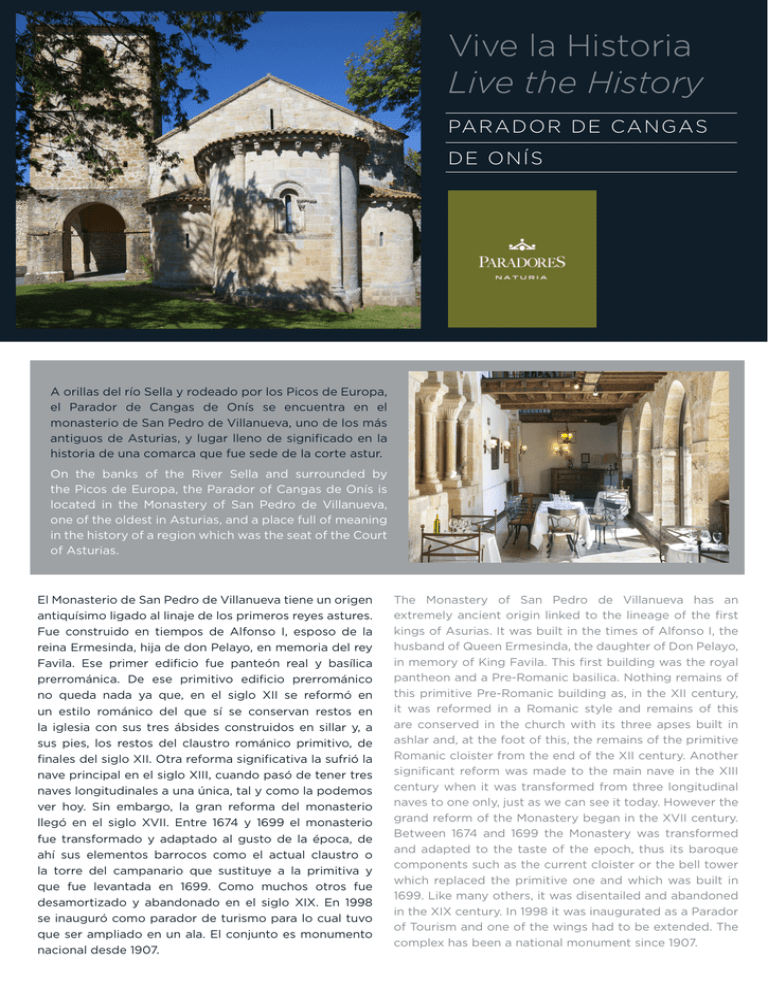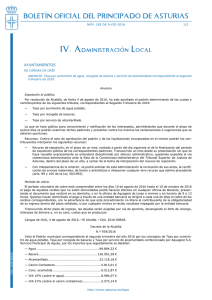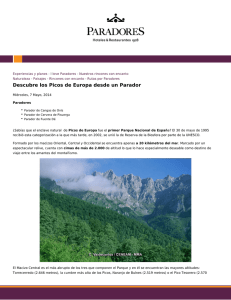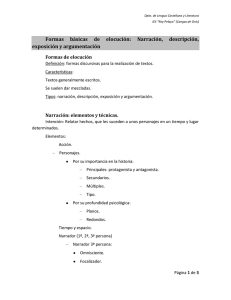Folleto Vive la Historia. Parador de Cangas de Onís
Anuncio

Vive la Historia Live the History PARADOR DE CANGAS DE ONÍS A orillas del río Sella y rodeado por los Picos de Europa, el Parador de Cangas de Onís se encuentra en el monasterio de San Pedro de Villanueva, uno de los más antiguos de Asturias, y lugar lleno de significado en la historia de una comarca que fue sede de la corte astur. On the banks of the River Sella and surrounded by the Picos de Europa, the Parador of Cangas de Onís is located in the Monastery of San Pedro de Villanueva, one of the oldest in Asturias, and a place full of meaning in the history of a region which was the seat of the Court of Asturias. El Monasterio de San Pedro de Villanueva tiene un origen antiquísimo ligado al linaje de los primeros reyes astures. Fue construido en tiempos de Alfonso I, esposo de la reina Ermesinda, hija de don Pelayo, en memoria del rey Favila. Ese primer edificio fue panteón real y basílica prerrománica. De ese primitivo edificio prerrománico no queda nada ya que, en el siglo XII se reformó en un estilo románico del que sí se conservan restos en la iglesia con sus tres ábsides construidos en sillar y, a sus pies, los restos del claustro románico primitivo, de finales del siglo XII. Otra reforma significativa la sufrió la nave principal en el siglo XIII, cuando pasó de tener tres naves longitudinales a una única, tal y como la podemos ver hoy. Sin embargo, la gran reforma del monasterio llegó en el siglo XVII. Entre 1674 y 1699 el monasterio fue transformado y adaptado al gusto de la época, de ahí sus elementos barrocos como el actual claustro o la torre del campanario que sustituye a la primitiva y que fue levantada en 1699. Como muchos otros fue desamortizado y abandonado en el siglo XIX. En 1998 se inauguró como parador de turismo para lo cual tuvo que ser ampliado en un ala. El conjunto es monumento nacional desde 1907. The Monastery of San Pedro de Villanueva has an extremely ancient origin linked to the lineage of the first kings of Asurias. It was built in the times of Alfonso I, the husband of Queen Ermesinda, the daughter of Don Pelayo, in memory of King Favila. This first building was the royal pantheon and a Pre-Romanic basilica. Nothing remains of this primitive Pre-Romanic building as, in the XII century, it was reformed in a Romanic style and remains of this are conserved in the church with its three apses built in ashlar and, at the foot of this, the remains of the primitive Romanic cloister from the end of the XII century. Another significant reform was made to the main nave in the XIII century when it was transformed from three longitudinal naves to one only, just as we can see it today. However the grand reform of the Monastery began in the XVII century. Between 1674 and 1699 the Monastery was transformed and adapted to the taste of the epoch, thus its baroque components such as the current cloister or the bell tower which replaced the primitive one and which was built in 1699. Like many others, it was disentailed and abandoned in the XIX century. In 1998 it was inaugurated as a Parador of Tourism and one of the wings had to be extended. The complex has been a national monument since 1907. TUMBA DE REYES Cangas de Onís fue la primera corte del reino astur hasta que ésta se trasladó a Oviedo en el siglo VIII. Fue Alfonso I, yerno de don Pelayo, el organizador de esta corte y el que ordenó la construcción del primer santuario en la gruta de Covadonga y de este monasterio donde comenzó la tradición de enterrar a los reyes astures. Este primer panteón real fue reemplazado posteriormente por el que se hizo en Oviedo en la llamada iglesia de Nuestra Señora del rey Casto. TOMB OF KINGS Cangas de Onís was the first Court of the Kingdom of Asturias until this was transferred to Oviedo in the VIII century. It was Alfonso I, the son-in law of Don Pelayo, who organised this Court and ordered the construction of the first Sanctuary in the grotto of Covadonga and it was in this Monastery that the tradition to bury the Kings of Asturias there began. This first royal pantheon was subsequently replaced by the one which was made in Oviedo in the Church of Nuestra Señora del Rey Casto. CAPITELES ROMÁNICOS Uno de los elementos más singulares del parador son los magníficos capiteles de la portada románica. Por su significado histórico destacan los dedicados a Favila, segundo rey de Asturias (737-739) e hijo del legendario don Pelayo. A pesar de su breve reinado fue un monarca muy popular ya que murió despedazado por un oso en la aldea de Llueves, cerca de Cangas de Onís. El capitel más interesante es el que narra la secuencia de la despedida de su esposa y, luego, el ataque del oso. ROMANIC CAPITALS Among the most singular components of the Parador are its magnificent capitals of the Romanic gateway. Those dedicated to Favila, the second King of Asturias (737-739) and son of the legendary Don Pelayo stand out due to their historical significance. Despite his brief reign, he was a very popular monarch and died torn apart by a bear in the village of Llueves, near Cangas de Onís. The most interesting capital is the one which narrates the sequence of the farewell to his wife and then the attack of the bear. TAMBIÉN LE GUSTARÁ: YOU WILL ALSO LIKE THE FOLLOWING: Paseo a pie por Cangas de Onís. Walking through Cangas de Onís Real Sitio de Covagonga. Real Sitio de Covagonga Lagos de Enol y Ercina. Lakes of Enol and Ercina Categoría: Convento Fecha: 1998 Arquitecto: Mariano Martitegui Cáceres BIC: Monumento Category: Convent Date: 1998 Architect: Mariano Martitegui Cáceres BIC (Property of Cultural Interest): Monument


